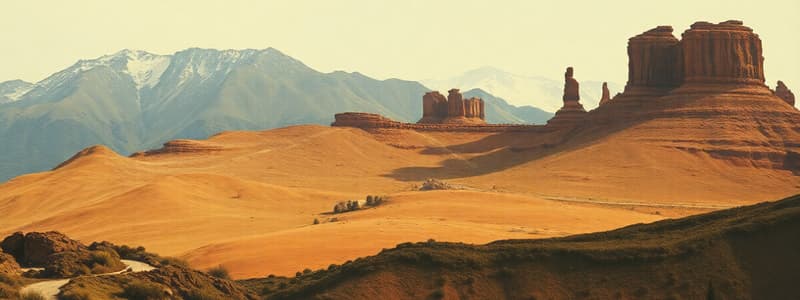Podcast
Questions and Answers
What is the characteristic feature of the subtropical climate zone?
What is the characteristic feature of the subtropical climate zone?
- It experiences extreme seasonal variations.
- It is characterized by low temperatures.
- It has evenly distributed rainy days throughout the year. (correct)
- It only has a wet season.
Which of the following statements about the tropical climate zone is true?
Which of the following statements about the tropical climate zone is true?
- It is known for extremely cold temperatures.
- It consists of only a dry season and a wet season. (correct)
- It has four distinct seasons.
- It experiences a continuous rainy season.
What type of natural resource can be reproduced or replicated?
What type of natural resource can be reproduced or replicated?
- Metallic resources
- Fossil fuels
- Living resources (correct)
- Nonrenewable resources
Which of the following best defines nonrenewable natural resources?
Which of the following best defines nonrenewable natural resources?
What distinguishes fossil fuels from other types of natural resources?
What distinguishes fossil fuels from other types of natural resources?
What does topography help us understand?
What does topography help us understand?
Which of the following is most closely associated with climate?
Which of the following is most closely associated with climate?
What type of map is specifically used to show the physical features of an area?
What type of map is specifically used to show the physical features of an area?
Which factor describes the height of mountains, valleys, and hills?
Which factor describes the height of mountains, valleys, and hills?
What characteristic defines the polar and subpolar climate zone?
What characteristic defines the polar and subpolar climate zone?
Which climate zone is characterized by smooth transitions between seasons?
Which climate zone is characterized by smooth transitions between seasons?
What does latitude measure in geography?
What does latitude measure in geography?
How does understanding geographic characteristics benefit people?
How does understanding geographic characteristics benefit people?
Flashcards are hidden until you start studying
Study Notes
Topography
- Topography is the physical features of a land area
- Topography describes natural formations such as mountains, rivers, lakes, and valleys
- Topography describes manmade features such as roads, dams, and cities
- Topography includes landforms
- Topography includes elevation, this is the height of geographical features such as mountains, valleys, hills, plateaus, glaciers, lakes, and rivers
- Latitude is the north/south position of a location in reference from the equator, a horizontal line drawn around the middle of the Earth
- Longitude is the east/west position of a location, generally measured in degrees from the Prime Meridian
Topographic Maps
- Topographic maps are geographical tools
- Topographic maps show the physical features of an area
- Topographic maps can be downloaded from namria.gov.ph/downloads.aspx#maps and gp (geoportal.gov.ph)
Climate
- Climate is the average measurements of temperature, wind, humidity, snow, and rain in a place over the course of years
- Climate zones are categorized by temperature and precipitation
Climate Zones
- Polar and subpolar zone: cool summers or not so hot summer days and very cold winters (places found in this zone usually have treeless tundra, glaciers, or a permanent or semi-permanent layer of ice)
- Temperate zone: no extreme temperature and precipitation, change or shifting of summer to winter and vice versa is generally smooth (not too cold and not too hot)
- Subtropical zone: has a relatively high temperatures, it usually experiences evenly distributed rainy days in a year
- Tropical zone: has only two seasons, the dry season and the wet season
Natural Resources
- Natural resources are naturally-made materials that can be used by humans for economic advantages
- Natural resources can be renewable or nonrenewable
Four Types of Natural Resources
- Renewable: they can be reproduced/replicated (example: planting of coconuts will make you produce another source of coconuts)
- Living: living resources such as plants and animals (sources of food and other materials)
- Nonrenewable: cannot be replaced once used/gathered (example: gold, silver, diamond, etc.)
- Fossil fuels: these are sources of power/energy sources (example: oil, coal, and diesel)
Studying That Suits You
Use AI to generate personalized quizzes and flashcards to suit your learning preferences.




